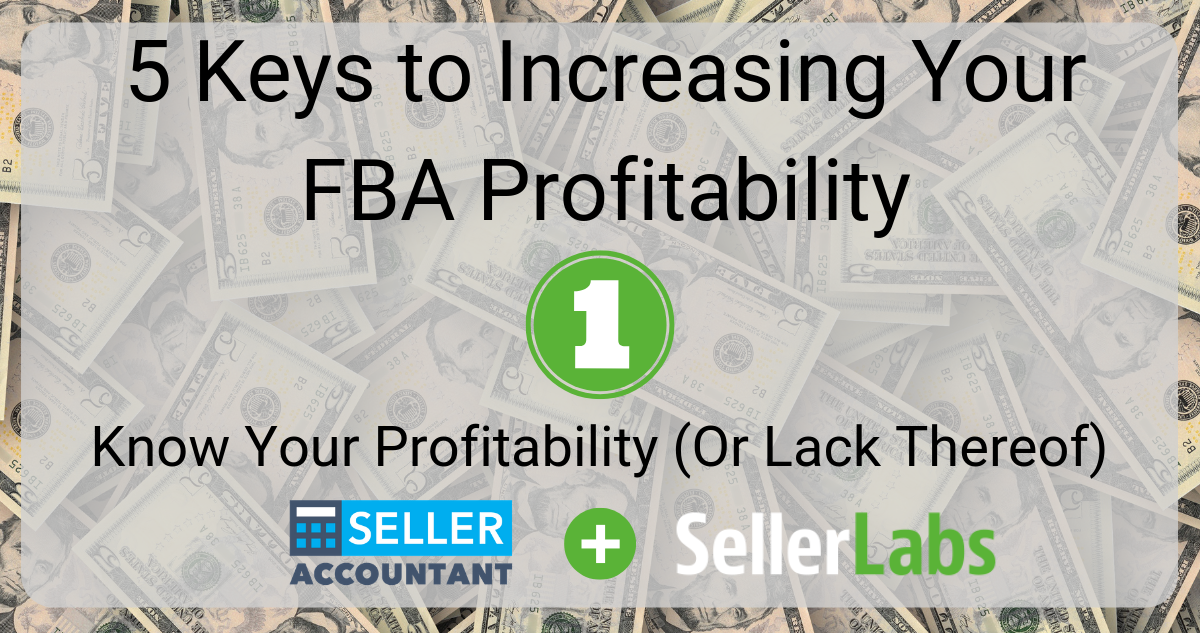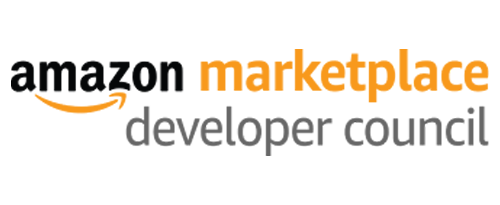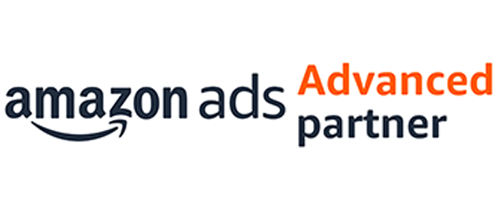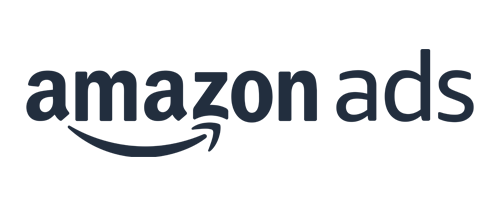Here at Seller Labs, we’re not accountants or financial planners . . . but we do work with experts in those fields, experts who happen to be some of the very best in the business. This week, we’re turning the blog over to one of those experts: Tyler Jefcoat of Seller Accountant. Enjoy Tyler’s series on the 4 Keys to Increasing Your FBA Profitability.
As business owners, we love talking about how much revenue our businesses produce but we get quiet when you ask us about profitability. Sales are exciting and crucial, but without profitability, sales are really just a vanity number.
Many business owners slowly wither away by working endless hours. They make money, but they aren’t profitable because their costs are just as high as their incomes. If this is you, don’t despair! Here’s the dirty little secret . . . EVERYONE struggles with profitability! When I say everyone, I mean not just Amazon sellers, not just e-commerce merchants, but EVERYONE in business! Profit is sanity, but it takes intense focus to run a profitable operation.
If you are an Amazon FBA seller and you don’t really know how profitable you are, or you’d rather not talk about it because your company is underperforming, this post is for you. The keys presented in this series are responses to some of the most common challenges that our customers at Seller Accountant have faced. My hope is that you can find and implement at least one nugget that will improve your bottom line! Let’s dive in.
KEY I KNOW YOUR PROFIT (OR LACK THEREOF)
At the risk of sounding too simplistic, the first key to improving your profitability is to know where you stand. Do you have an accounting system that gives you clear insight into where your money is going and how your company is performing? If you don’t have a clear handle on how much the following categories are costing you, it will be nearly impossible to know where you must improve.
- Landed CoGS: Make sure you know what your total Landed Cost of Goods Sold is. Many sellers make the mistake of modeling based upon how much they think they will make on new SKUs . . . without factoring in important costs like customs, freight, and tariffs. Because inventory management is so challenging, it’s critical that you take the time to dig into your purchase orders and 3PL invoices in order to truly understand what your landed costs are for each product. You may be surprised to find that one of your top-selling SKUs is actually losing you money.
- All Amazon Fees: It is really important to fully analyze your Seller Central reports so that you can understand what your Amazon FBA fees are. Don’t assume that you know what your fulfillment costs are; Amazon fees change often and you may be shocked to find out exactly how much of your money is going to avoidable fees like long-term storage.
- Amazon Advertising Costs: You cannot afford to “set it and forget it” with your Sponsored Products campaigns or Headline Search Ads. There are simply too many variables and too much competition. It is critical to keep an eye on each campaign and tweak your bids to ensure that you aren’t throwing money away on losing keywords or underperforming campaigns. The best way to guarantee that you’re bidding the right amounts on the right keywords is to use a tool like Ignite where the application provides suggestions based on actual sales trends and Amazon’s algorithms.
- Overhead: Once you understand and tighten up your Amazon business expenses listed above, take a close look at your operating expenses. Many sellers are spending thousands of dollars on unused tools, underutilized subcontractors, and other unnecessary expenses. If you are struggling to achieve profitability take a close look at your non-critical expenses and cut everything that doesn’t directly increase sales, improve efficiency, deliver key value to your customers, etc. Once you are happy with your profitability you can reinstate that Netflix subscription. 🙂
Look at your profit-and-loss statement closely in order to really understand where your money is going. If you can’t decide if an expense is critical or not, get someone else to weigh in. For any questions along the way, feel free to contact our team!
KEY II MARGIN + VELOCITY = PROFIT
The struggle for profitability is something that each and every business owner endures. There’s more to gaining profit than just ensuring your margins are manageable. What happens if your FBA shipment isn’t moving? You’ll incur Long Term Storage Fees and your margins will shrink. True profitability lies in both margins and sales velocity.
Here’s a key question for every Amazon seller: For every dollar that you invest into your your business, how much do you get in return and how long does it take you to get your return? If you aren’t happy with the overall profitability of your company, one of two factors is probably the culprit: profit margin or sales velocity.
Most businesses need to fight for more margin. If your products produce margins of 15% or less once you account for fees, returns, CoGS, and advertising, then you need to look for new ways to differentiate your product either by building brand awareness or improving your designs. If you can’t find the needed margin by building your audience, it’s time to develop new products that are more profitable.
By the way, having to replace low-margin products doesn’t mean that you’ve done something wrong. It could be that a bunch of new competitors have entered the market and it’s time to adapt in order to stay profitable and relevant. Building the value of your brand and constantly adjusting your product catalogue in order to fight for margin is the name of the game for most merchants not named Walmart.
Walmart plays an extreme version of the classic high-velocity, high-volume game. Walmart’s gross margin is pretty consistently 24%, but its net profit was 1.74% in a recent quarter! Margins that low would crush almost any of us, but Walmart is so large that it can actually win the low-price battle fairly often and make it up with volume. The rest of us literally cannot compete.
As Amazon has grown and become involved in all aspects of the supply chain, it too is able to play the high-velocity, high-volume game. And since Amazon has access to some the cheapest capital in history, it (like Walmart) can sustain high-volume, low-margin products for quite some time. Since you and I are not Walmart or Amazon, our profit margins MUST be bigger and better to offset the lower volume.
Improving margins should be our first focus but sales velocity matters! Find ways to improve velocity by building brand awareness and by optimizing your advertising.
KEY III VIEW EACH PRODUCT AS AN INVESTOR, NOT AS A PARENT
When you pour your heart and soul into your business, it’s difficult to remove the emotive ownership. However, good business owners are those who remove emotion from decisions, whether it’s pulling a product line or cutting ties with a manufacturer to decrease costs.
Do you have children? I have two beautiful kids and I love them no matter what. You love your babies too for lots of reasons, including the fact that you made them, they are yours, they do the funniest things, etc… No good parent will dump a child because the child isn’t performing up to par. Our kids do things that get on our nerves and so we don’t like them sometimes, but we still love them. We’re attached and invested—for life.
Being a business owner requires you to think like an investor and not like a parent, even when you feel attached to a product because you made it. Investors love high-margin products that are popular, profitable, and protectable. And they are still happy with medium-margin products that fly off the shelves. But as an investor, you HATE products that sit in inventory for 9 months and then still don’t make you much money when they do finally sell.
- The investor is willing to ask the hard question: Does this product belong in our brand family?
- And the investor is willing to make the tough call, namely to drop the weak products and move on to try new investments in pursuit of a winner.
Products are objects. They don’t have feelings so you can’t offend them or do them harm by cutting your losses. That said, please continue loving your children regardless of what kind of year they are having (and there will be some tough ones for sure). But take the time to understand each product’s profitability and don’t be afraid to cut it. It, unlike your child, is replaceable. With an investor’s mindset, you will have the courage to discontinue bad products and you will be more profitable as a result.
KEY IV SPEND YOUR TIME WHERE YOU MAKE YOUR MONEY
The last key in the series is one of the most important. Business owners, especially in the beginning, find that they need to do it all. They become knowledgeable in a multitude of different areas, but their expertise rarely gets a chance to shine and scale the business.
My dad has often told me, “Spend your time where you make your money.” What he means is that it’s easy to get caught in the whirlwind and minutia of your business and to stop doing the most-important things that have made you successful and keep the lights on.
If your core strength is developing new products, then you need to be spending your time developing new products not managing Amazon ads. If you are best at negotiating purchases and supplier deals, then stop doing almost everything else and instead focus on using your skillset to make your company more money.
The point is that none of us is good at everything, but as startups, we have to wear all hats. When things are small, we manage everything and don’t have too much trouble making time for the most-important things. But as companies grow, most entrepreneurs fail to transition to being CEOs instead of one-person-shops. This has huge implications for your profitability because your business needs you to do those things that you are best at. Handing over control of the rest is difficult, but you need to free yourself to do the work that works for you.
If you realize that you are not spending your time where you add the most value for your company, here are 3 ideas to help you embrace your CEO role.
- Outsource: Find as many headaches as you can and offload them to companies or employees that specialize in handling those headaches effectively. If accounting and bookkeeping aren’t your thing then don’t be afraid to outsource them to a company that specializes in accounting for e-commerce. My company, Seller Accountant, is a firm that specializes in owning your accounting so you can focus on doing what makes you money. Similarly, Seller Labs offers a program where their experts will handle all of your Amazon Advertising so you can shine elsewhere.
- Automate: If you are still copying and pasting individual orders for your business, or if you are trying to manage your inventory manually using a spreadsheet, or if you are manually managing ad campaigns for hundreds of SKUs, please stop! Investigate and invest in automation tools like Feedback Genius and Ignite. Often these tools can do a better job than you can do manually and they’ll save you literally hours of work per day. If you don’t find a good tool for your process, or if your process is highly specialized, there are companies like Data Automation who will build custom integrations for you so you can stop unnecessary time-consuming manual processes.
- Document Your Processes: Finally, for processes and tasks that need to be done by you or a human employee, take the time to map out how to properly do the process and what the end-goal is so that you can easily train new employees as you scale up.
Do these things so that you can take my dad’s advice and spend your time where you make your money
So, if you want to be more profitable, you must know all of your expenses, fight for margin and velocity, think and behave like an investor, create a compelling scorecard, and spend your time doing what you do best. You can’t do everything at once, but you can pick one or two tips for Amazon Sellers from this list and commit to taking action this week! Your nerves and your bank account will thank you.
CONCLUSION Profitability Will Make or Break Your Amazon Business
If you need help managing profitability or your books, Seller Accountant would love to assist you. To go a step beyond that, Jeff Cohen sat down with Tyler to go over a bit more of the day-to-day, “in the trenches” details of monitoring your profitability.
Whether you’re a new business or someone who has been selling on Amazon for years, profitability should be in the front of your mind. Jeff asked Tyler three questions, with the goal of you tackling profitability analysis in house, before you’re so successful that you need to hire an expert like Seller Accountant.
- What are some common mistakes that Seller Accountant often needs to fix when starting with a new client?
- If I want to monitor my profitability in house, what do I need to be considering? Any tool recommendations?
- When sellers are becoming more successful or looking to sell their business, what do they miss when sharing profitability?

Don’t forget to implement the 5 Keys to Increasing your Amazon FBA Profitability as well! Even one has the ability to make a huge impact on your business.
It you’re interested in hiring Seller Accountant or learning about their services, head over to SellerAccountant.com, or email tyler@selleraccountant.com. Thanks for the blog takeover, Tyler!
Tyler Jefcoat, Co-Founder, and CEO of Seller Accountant is a longtime accountant and successful business builder who excels in helping stressed-out owners regain their lives while driving superior financial results.







